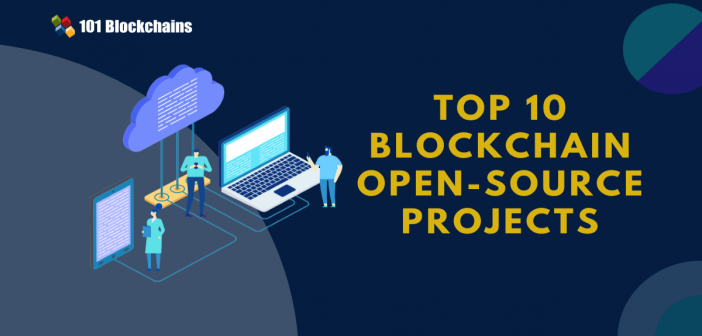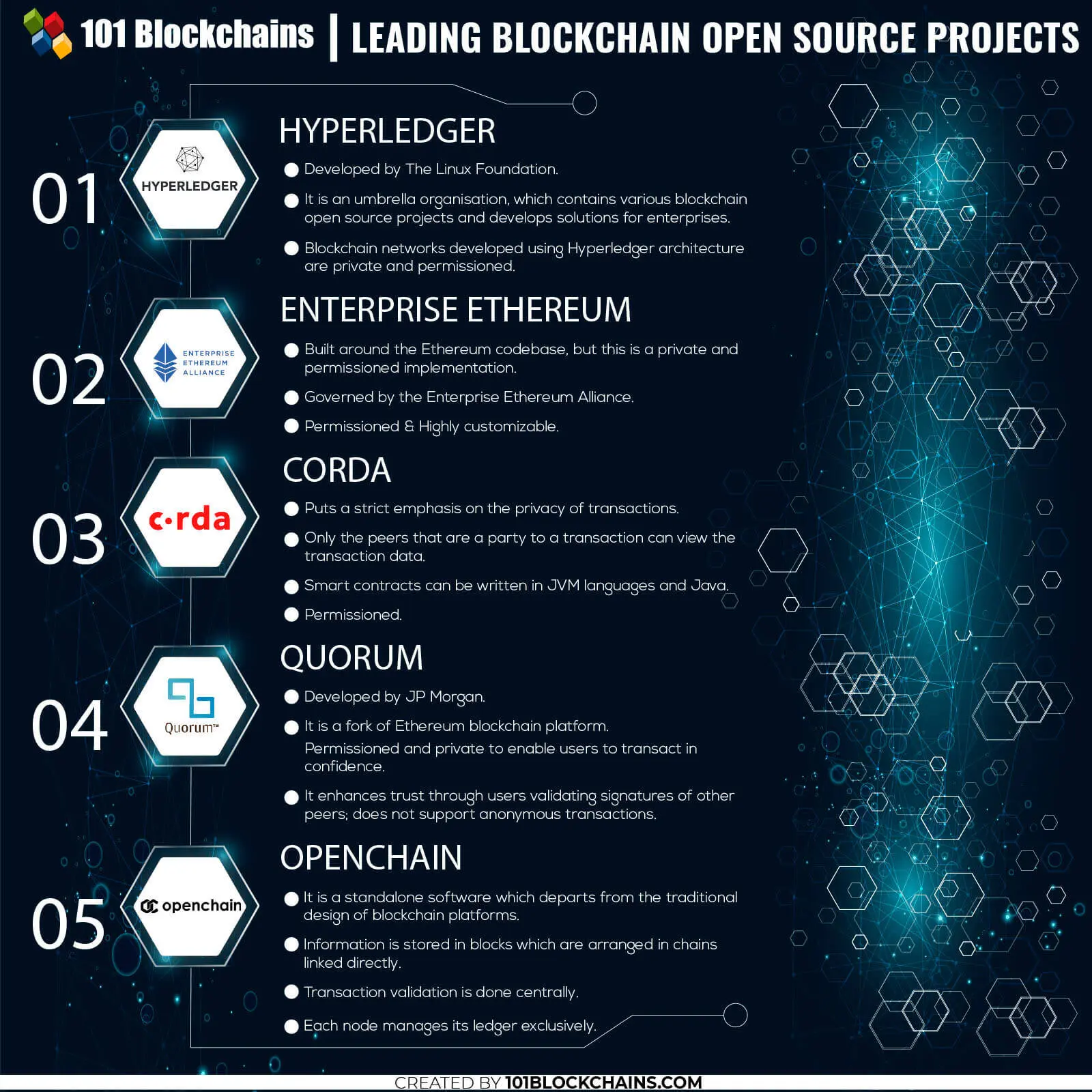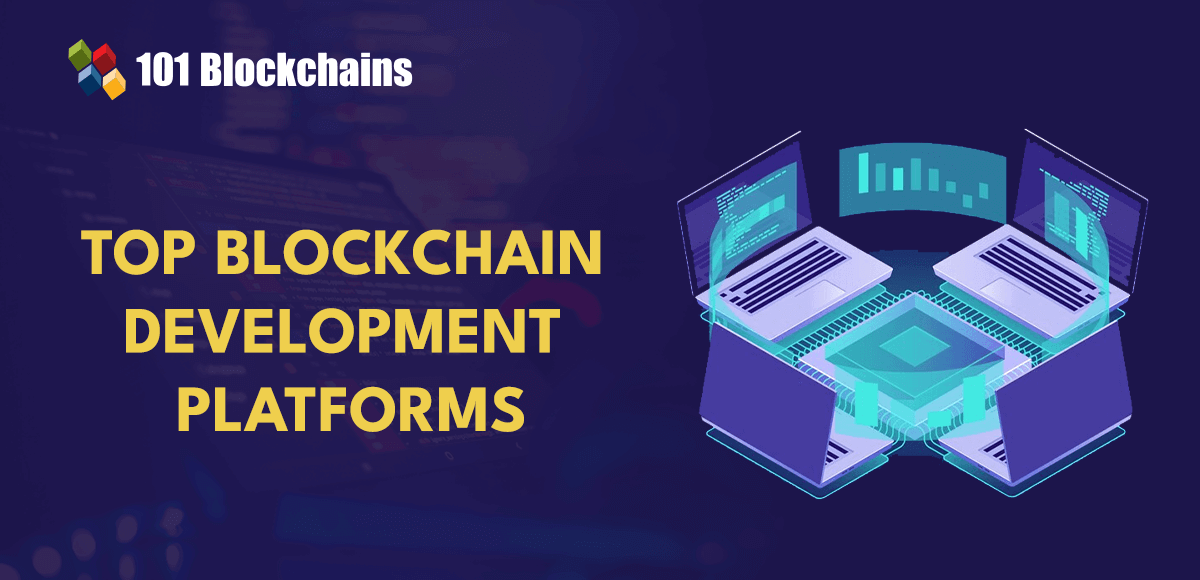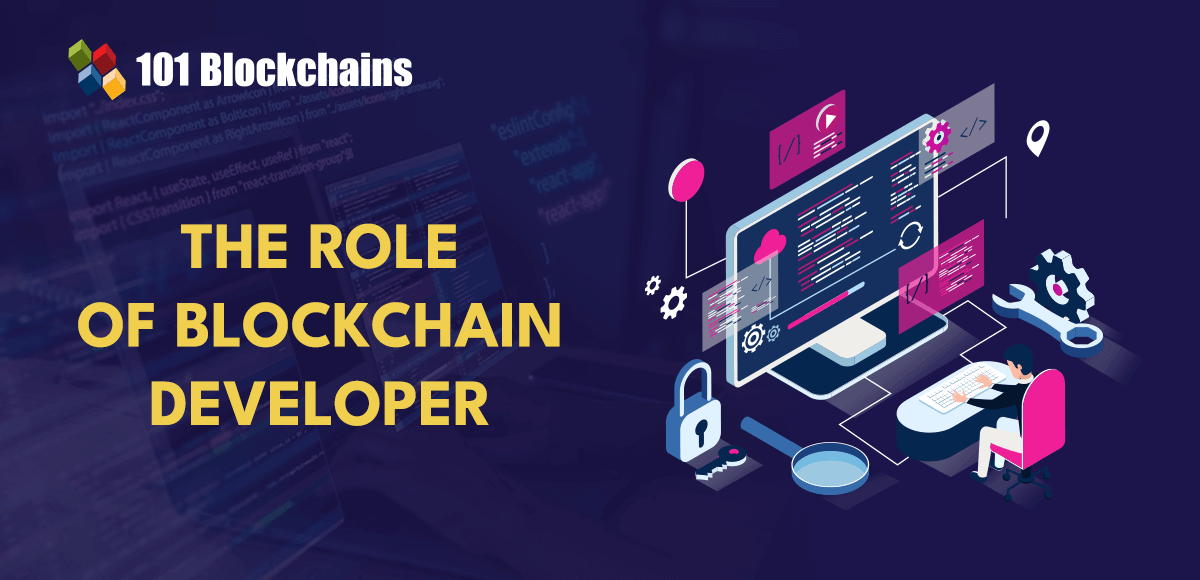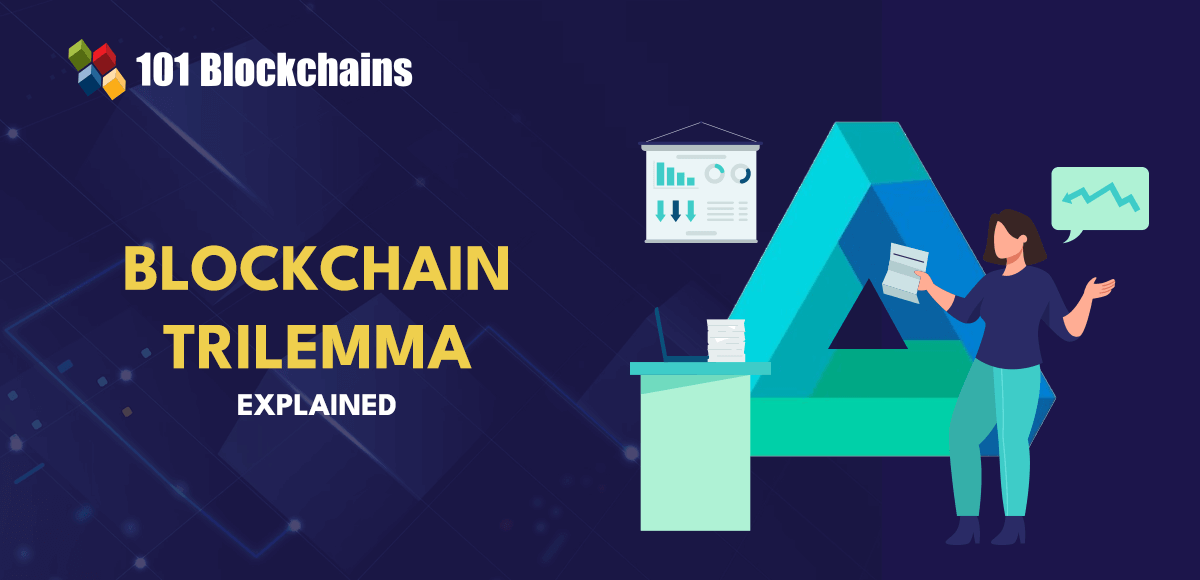Blockchain has been the buzzword of the year for almost a decade now, and that doesn’t seem to stop any time soon. While the technology gained popularity with Bitcoin, mainstream adoption has been slow. However, it’s blockchain nature can drive its mainstream adoption. In this article, we will be exploring blockchain open source and how it can accelerate its mainstream adoption.
A Brief Look at Blockchain Technology
For ease of understanding, let’s first understand blockchain technology, and what it has to offer.
Blockchain technology is an innovative application of the distributed ledger to create a network of connected nodes. Assume the blockchain platform to be a Google spreadsheet. This spreadsheet is distributed among computer networks, and each user within the network has a copy.
Every time a real person commits a transaction, the information is recorded on the spreadsheet, and all participants on the network can access it. The significant upside is that none of the users can edit the information.
Blockchain technology has key features that make it more appealing.
First, there is no central authority that mediates transactions between peers. As such, the direction of peer interaction allows for expedited and secure transactions.
Second, the ledger is distributed across the ecosystem, and each node can access the same information. Hence, a bad actor cannot successfully tamper with the data on the ledger.
Third, a blockchain network is built around the concept of cryptography. Essentially, bad actors cannot tamper with the network unless they bypass the robust cryptography systems put in place.
Fourth, once data has been committed to the public ledger, no user can change it.
Lastly, users can agree via consensus to add data to the platform. This is where the technology gets its decentralized attribute and hence the name Distributed Ledger Technology (DLT).
Build your identity as a certified blockchain expert with 101 Blockchains’ Blockchain Certifications designed to provide enhanced career prospects.
Blockchain Open Source
When blockchain technology became public, it mainly targeted the financial sector. In particular, the bitcoin white paper outlined a system that would enable users to transfer cash from point A to point B without having to rely on traditional channels. The new channel would be peer-to-peer, as explained above.
However, blockchain has now spread beyond finance, and its applications are apparent in data management, e-commerce, e-governance, online voting, energy, gaming, and other sectors.
In the wake of these new applications, various commercial blockchain platforms are making their inception.
During the same time, a blockchain open source community formed which launched blockchain open source projects for the advancement of the industry.
Whether commercial or open-source, a blockchain platform is primarily built to satisfy the following conditions.
First, a blockchain platform must have a database that is transactional and working. As such, users should be able to transact with their peers anytime.
Secondly, a blockchain platform should have user identification labels that facilitate transactions among active users.
Thirdly, the platform must provide mechanisms for the verification of transactions before they are approved.
Lastly, the platform must have systems in place to stop transactions that cannot be verified.
Open source blockchain platforms enable developers to create decentralized applications (dApps) that provide solutions for various problems. The demand for open source software is heating up as businesses continue to adopt the technology increasingly. Enterprise blockchain is the next big thing for technology which is mostly unknown to many people as yet. However, this kind of adoption is an invitation to mainstream use.
Curious to learn about blockchain implementation and strategies? Enroll Now in Blockchain Technology – Implementation And Strategy Course!
Best Blockchain Open Source Projects
The increasing demand for enterprise blockchain has pushed the industry to create more open source projects where each has a unique blockchain open source framework.
In particular, each of the projects seeks to achieve a specific objective in the industry. The solutions cut across all sectors with the financial industry, the most explored.
Please include attribution to 101blockchains.com with this graphic. <a href='https://101blockchains.com/blockchain-infographics/'> <img src='https://101blockchains.com/wp-content/uploads/2019/05/Blockchain-Open-Source.jpg' alt='Blockchain Open Source='0' /> </a>
The supply chain sector has also seen several projects so far unveiled with tailored solutions. In light of this, some of the best blockchain open source projects include:
1. Hyperledger
Having realized the potential of blockchain technology, The Linux Foundation gathered a group of cross-industry executives to found the Hyperledger Project. This is a blockchain-free open source platform that offers wide-ranging tools and frameworks for developers to create enterprise-focused solutions.
Under the Hyperledger umbrella, an enterprise can experiment with blockchain platforms aimed at creating solutions across all industries.
There is a Technical Steering Committee (TSC) whose core responsibility is to review and approve technical contributions from all the members of the Hyperledger community to keep the open-source environment alive within the community.
The TSC consists of leading experts drawn from across industries, and it is committed towards “open and transparent discussion, decision making, and processes.”
Some of the critical responsibilities which the TSC undertakes include overseeing the working groups and the technical direction of the community.
Also, the committee will evaluate the contributions proposed by members. The need for the TSC is to ensure that there is a unified codebase for all projects under the purview of Hyperledger. Over and above the TSC, there is the Governing Board, which makes critical management decisions.
Excited to learn the basic and advanced concepts of Hyperledger Fabric? Enroll Now in Getting Started with Hyperledger Fabric Course
Blockchain Open Source Projects under Hyperledger
-
Hyperledger Fabric
Building on the open-source nature of Hyperledger, various members have developed projects with a focus on multiple industries.
One of the most popular, and widely adopted projects is Hyperledger Fabric. The robustness of this platform has propelled it to the status of the de-facto standard for projects focused on enterprise blockchain. Notably, developers have access to a unique consensus approach that facilitates performance at scale. At the same time, the platforms are highly interoperable within a network-of-networks environment without compromising on privacy.
Hyperledger Fabric is one of the best open source blockchain frameworks for its innovativeness. Through open governance and open source, developers and enterprises can create trustable applications which uphold accountability and transparency.
Presently, one can create permissioned and permissionless networks via Hyperledger Fabric.
The framework enables confidential transactions, and it comes with a pluggable architecture. As such, it is quite natural for anyone to get started with developing an application for their solutions. Notably, the robustness of Hyperledger fabric is underlined by the great number of engineers working with the framework. In particular, 28 organizations and 159 engineers are currently utilizing the framework.
-
Hyperledger Sawtooth
Hyperledger Sawtooth is the second most popular open source platform under Hyperledger umbrella. Like Hyperledger fabric, Hyperledger Sawtooth provides an enterprise-grade framework which developers can utilize to create dApps.
Developers and enterprises can create, deploy, and execute dApps without having to rely on a central authority.
Hyperledger Sawtooth is a collaborative effort between Digital Asset and IBM. Unlike other blockchain platforms, Sawtooth leverages Proof of Elapsed Time (PoET) as the consensus mechanism. The mechanism creates trusted execution environments which integrate smoothly with hardware security solutions.
Sawtooth is at the forefront to push the open source ambitions of the Linux Foundation. The software solutions are built around the Hyperledger code, which makes it easy to upgrade without experiencing network failure. Like many other enterprise blockchain platforms, Sawtooth is permissioned blockchain and has a pluggable framework.
Start learning Blockchain with World’s first Blockchain Skill Paths with quality resources tailored by industry experts Now!
2. Enterprise Ethereum
In addition to being the platform that popularized smart contracts, Ethereum is of massive importance to enterprises. Conveniently dubbed Enterprise Ethereum, this platform allows developers to create blockchain solutions aimed at servicing enterprise users. Unlike the traditional Ethereum network, which is public, Enterprise Ethereum is permissioned for the same reasons as HydraChain, Corda, and Hyperledger.
Basically, this platform is an implementation of the Ethereum codebase. With this network, organizations can create decentralized applications (dApps). The dApps can be tested and deployed within the ecosystem without any downtime. Due to the inherent characteristics of blockchain technology, the dApps created here cannot be censored, interfered with by third parties or used for fraudulent endeavors.
Enterprise Ethereum is governed by the Ethereum Alliance. Organizations which want to leverage the platform are first members of the alliance. At present, member organizations are cross-industry. Some of them are Accenture, Microsoft, Advanced Micro Devices (AMD), Banco Santander SA, BBVA, Deloitte, among others.
Excited to learn the basic and advanced concepts of ethereum technology? Enroll Now in The Complete Ethereum Technology Course
Major selling points for Enterprise Ethereum
-
Highly customizable
Unlike the traditional Ethereum platform, Enterprise Ethereum allows the developer to change the network size for the best scale. Also, developers can tweak the block size as well as the gas limit to ensure the best running of the network. In particular, the main use of an enterprise blockchain platform is to enable users to create applications which will allow enterprises to perform better.
-
Reduced cost of trust
Like earlier mentioned, Enterprise Ethereum is an implementation of the Ethereum codebase. This is to say that organizations (which are now the peers on the enterprise Ethereum platform) can interact directly and securely without intermediaries. Also, such proximity between users increases chances for collaboration on groundbreaking endeavors. Besides, the immutable nature of the data on the platform makes it easy in a radical manner for users to access and manage data.
-
Better efficiency
Legacy business operations are paper-based hence cumbersome and inefficient. On the contrary, a blockchain network eliminates the need for papers in peer-to-peer transactions, which increases efficiency. Parties with sufficient authorization can exchange transaction records and data using smart contracts. The process automates and streamlines transactions such as ID verification, supply chain management, and so on in a radical way.
Curious to understand the complete smart contract development lifecycle? Join the Standard & Premium Plans and get free access to the Smart Contracts Development Course Now!
3. Corda
Corda is another popular blockchain platform, especially since it puts strict emphasis on the privacy of the information concerning transactions among peers.
Corda blockchain is business oriented. It is underlined by the ability for developers to create blockchain networks which are interoperable but with the strict privacy policy. Companies using solutions built on Corda can transact directly.
The key features of Corda include smart contracts which can be written in JVM languages as well as Java. Also, the platform is built around flow framework where negotiations and communications between users can be managed smoothly.
Also, the nodes within the network interact on a peer-to-peer basis. Additionally, the platform supports a notary infrastructure that facilitates the sequencing of transactions as well as validating their uniqueness without global broadcast.
Specifically, Corda is built for all the enthusiasts who would want to create robust applications for cross-industry solutions. Notably, the platform has Apache 2.0 as its blockchain open source license which it acquired in 2016.
As a blockchain open source example, Corda has differentiated itself as a platform where transactions are not public. Typically, traditional blockchain platforms like Bitcoin and Ethereum make sure that all the transaction info is public to enhance verifiability. However, this was a major stumbling block for enterprise blockchain, considering that most enterprises want to hold their transactions data private for strategy’s sake. No business would want to expose its soft underbelly to competitors!
Since Corda is permissioned, all nodes automatically trust each other because no one would be able to transact without having first undergone strict KYC procedures before gaining access to the network. Technically speaking, Corda is trustless. This is to say that completing transactions on the platform does not require network-wide consensus. Specifically, only the nodes which are a party to the transactions will need to verify transactions.
This trustless mechanism implies that the transaction’s speed is modest compared to traditional platforms. For starters, transaction per second (TPS) is a key threshold that will determine the pace of mainstream adoption of blockchain. Therefore, whoever succeeds to speed up the TPS to the level of card companies like MasterCard and VISA will win many enterprise clients.
Excited to learn the basic and advanced concepts of Corda Development? Join the Standard & Premium Plans and Enroll Now in Beginner’s Guide To Corda Development Course!
4. Quorum
For starters, the blockchain ecosystem first evolved as a financial sector product which enabled people to exchange value in a decentralized manner. The first medium of exchange over a blockchain platform was Bitcoin. With the growth of blockchain, it began to move away from the financial sector and branching into every industry in existence. However, the emergence of enterprise blockchain ruired the development of an enterprise blockchain platform solely developed for the financial sector. This is what Quorum seeks to fulfill.
Quorum was developed by JP Morgan. The platform is a fork of Ethereum, and it aims to provide the financial sector with the full benefits of blockchain. Notably, the onboarding of JP Morgan onto the blockchain ecosystem is a major step toward the mainstream adoption of the technology. The primary objective of the network is to provide a permissioned blockchain network based on the Ethereum codebase, which enables private transactions.
Key features of Quorum
-
Trust
There is no industry where trust is more valuable than in the financial sector. Quorum takes this to the next level by providing a platform whose digital trust is intrinsic to the system. That means one can prove and validate information without the help of external, trusted organizations. Also, users can verify signatures of other peers, a feature that is not available in Ethereum where people can transact anonymously.
-
Collaboration
Given the fact that Quorum is open source, there is a vibrant community of organizations that would like to try the platform. As such, there are diverse perspectives that foster collaboration among peers.
-
Maturity
Quorum utilizes the Ethereum codebase. As such, the platform will track the development of Ethereum, which among the pioneering blockchain platforms. Therefore, as Ethereum matures, Quorum will grow alongside it, and that will benefit the users to a great extent.
Want to learn the basic and advanced concepts of Ethereum? Enroll in our Ethereum Development Fundamentals Course right away!
More Blockchain Open Source Frameworks
Apart from Hyperledger and Corda, there are several blockchain open source frameworks that provide a healthy alternative for developers. Some of them include:
5. OpenChain
This is a standalone blockchain platform that departs from the traditional design and architecture of a DLT network. Notably, OpenChain abandons the concept where transaction information is stored in blocks that are arranged in a chain. As such, this makes the network highly scalable and robust. Further, this implies that users can easily achieve TPS, which is yet recorded on traditional enterprise blockchain platforms.
Instead of chains of blocks, the OpenChain architecture links transactions together directly the moment users submit them. This is quite revolutionary, even if the whole blockchain ecosystem is just beginning to gain global attention.
How OpenChain works
Having understood that OpenChain does not work like traditional blockchain networks, one must wonder how then it works. Here is how.
First, OpenChain is more centrally managed compared to traditional blockchain networks. This is because the validation of transactions is done by a single authority.
Secondly, every node within the OpenChain ecosystem has its own ledger which has exclusive control over. This goes against the traditional architecture of a blockchain network where there is a single ledger that is shared across all the nodes.
Further, OpenChain has a modular architecture. They are as follows:
First, there are storage engines where records and transaction chains are stored.
Examples of components in this module include OpenChain.SQLServer, OpenChain.SQLite and OpenChain, MongoDB. The second module is the validation engines, while the last one is the anchoring media.
The robustness of the network is founded on the speed with which developers can create applications.
Notably, a new instance of OpenChain can go live within a matter of seconds. Every OpenChain instance has an administrator who is also in charge of the operations of the ledger. The administrator sets the standards to which end users must adhere. Also, transactions are validated using digital signatures as it happens on the Bitcoin network.
Want to become a bitcoin expert? Enroll Now in Getting Started with Bitcoin Technology Course
6. Multichain
Another interesting blockchain open-source project is MultiChain. It is an enterprise blockchain. According to the official website, any organization using MultiChain can cut their development time by 80%.
At the core, its idea is to provide the tools and techniques to make blockchain application deployment faster.
Some of its key features include rapid deployment, data streams, fine-grained permissions, and unlimited assets. Let’s go through its key features below.
-
Rapid Deployment
Multichain is very efficient when it comes to rapid deployment. You only need two steps to create a new blockchain. You also need three steps if you want to connect to an existing blockchain. There is also no limitation when it comes to deploying blockchain.
-
Data Streams
It enables you to create data streams with the help of key value. This means you can connect to multiple databases at the same time for improved timestamping, data sharing, and high-level encryption. Unlimited assets
You can create and deploy unlimited assets on the blockchain using Multichain.
-
Open source
The blockchain project is completely open source. This means that you can contribute to the core. You can also make changes to the code base if the need arises.
-
Fine-grained permissions
You also get access to a proper permissioning system.
Other key MultiChain features include the following.
- Customizable
- Flexible security
- Developer friendly
Not sure how to build your career in enterprise blockchains? Enroll Now in How to Build Your Career in Enterprise Blockchains Course
Final Words
So, these are different Blockchain open source projects that you should know about. You can also try them if you are aspiring to build a career in blockchain. We at 101Blockchains offers training courses and certification programs for blockchain enthusiasts to learn Blockchain, build blockchain skills, and recognize those skills.
If you are the one who has great potential to participate in the blockchain race, we invite you to try out our Free Blockchain Course and take the first step to start your blockchain journey!
*Disclaimer: The article should not be taken as, and is not intended to provide any investment advice. Claims made in this article do not constitute investment advice and should not be taken as such. 101 Blockchains shall not be responsible for any loss sustained by any person who relies on this article. Do your own research!

